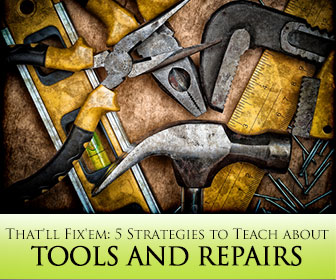Would You Mind Speaking Up?: 5 Must-Have Tools for Improving Spoken English


Everyone is going to need to repair things. It is important that your students have the language in those cases. Help your ESL students gain the vocabulary and expressions to talk about fixing things around the house or at work with the strategies below.

First and foremost, your students need to acquire the vocabulary for tools and repairs. Introduce the names of tools by actually having the tools there, if possible. When introducing the actions, perform them, if possible. This is a great way to involve students who may be reluctant to speak aloud. They may feel comfortable enough to participate in a kinesthetic activity even though they do not want to speak aloud in front of the class yet. Also, have their names written clearly to go along with them. Take time and review pronunciation as necessary. Be sure to note how some actions have the same name as the tool that goes with it, such as you hammer with a hammer and saw with a saw. You will also want to cover the various jobs that go along with this topic, such as a plumber or a mechanic.
Your students may need to go to a hardware store to purchase tools. Doing this activity will prepare them for it. You will need to set up your classroom to look like a hardware store. You may want to have either a toy cash register or a calculator available. First, go through a few simple scripts of people shopping at a hardware store. Allow the students to practice these scripts using the tools and the cash register if possible. As the students become more comfortable with using the vocabulary, encourage them to have spontaneous interactions regarding the tools. This may be easier with intermediate and advanced students, but can be done with beginners if they have a lot of support with the vocabulary. They would need to feel comfortable. This role playing activity will build confidence for when they actually go shopping at a hardware store. Depending on your program, you may be able to go on trips. If that is the case, see if you can plan one to a local hardware store. Set it up ahead of time so the staff there will be aware that you are all going to be there, and what your purpose is. This real-world experience will help your students use their vocabulary more spontaneously.
It’s always a great idea if you can get guest speakers to come into your class with their real-world experience. In this case, that would mean finding someone who is in a business where repairs are done. Invite a mechanic or handyman in to discuss how they use some of their tools. It would be a good idea if in the class before you have the students brainstorm questions they can ask the guest about repairs. Then they will feel more comfortable when the guest arrives about using their English skills. Let the guest talk about what he does on an average day, and then have the students ask their questions. After that, see if any students feel comfortable asking the guest a spontaneous question. This is bound to be a rewarding experience for the students, the guest and you.
Often we use tools because something has gone wrong. In this exercise, students will address different possible problems and decide what tools would be used to fix them. Begin by reviewing the names of the tools and the actions for each. Have the tools you used to introduce the vocabulary with you, if possible. You will need to prepare cards ahead of time that give sample problems you would need tools to fix. For example: Your car has a flat tire. What should you use and what should you do to fix it? You will need at least one card per student. Students will each take a card. They will look at their card and decide what they should use and what they should do to resolve the problem. If the class is able to write, they should write down the tool(s) they will need, along with one-three steps to fix their problem. They should take turns sharing what they have written. Have them actually perform the action and touch the tools if at all possible. If they are not able to write, they should just take turns showing which tool and stating the steps they would take. This activity helps with spontaneous thinking in English, which is always one of our goals.
This can be a fun activity with a little imagination. Review the list of possible occupations that involve repairing. Let the students know they are going to try on one of those jobs for size today. If it is a class of adults and they actually do one of those jobs, let them choose their true job even if it means you have repetition of jobs in the class. It would be great for those students to practice using their English work jargon in a supportive environment like their ESL class. If none of those are their occupations, let everyone in the class choose a job. See that there is as little repetition as possible unless necessary. Have them write three sentences (or say, if they do not write in English yet) about what they do as if they were that type of worker. For example, a mechanic: “I fix cars. I change oil. I check the brakes.” The sentences should reflect the skill level of your students. After they read their sentences, the other students should guess which type of worker they are talking about.
Using these strategies, you will be able to help them get the vocabulary and expressions they need to feel comfortable talking about it in English.